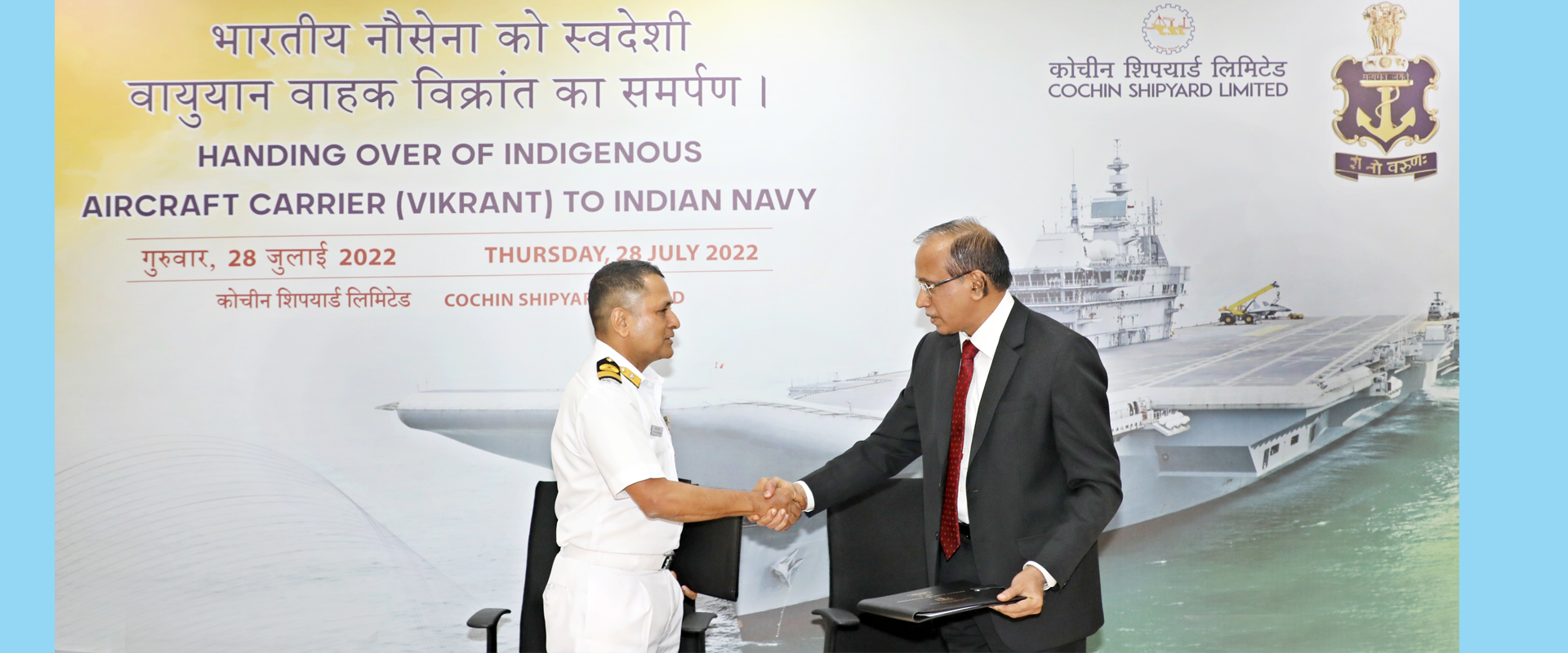India's first Indigenous Aircraft Carrier, equipped with state-of-the-art technology, will further strengthen the Navy’s defence.

Madhu S. Nair, Chairman and Managing Director, CSL and the Commanding Officer (Designate) of the vessel Commodore Vidhyadhar Harke Signs the acceptance form of the contract.
“INS Vikrant is an example of the government’s thrust to making India’s defence sector self-reliant,” said Prime Minister Narendra Modi after inaugurating India’s first indigenous aircraft carrier (IAC) that is INS Vikrant on the Cochin Shipyard premises.
A prestigious vessel designed by the Indian Navy’s in-house Warship Design Bureau (WDB), INS Vikrant was built by Cochin Shipyard Limited, a public sector shipyard under the Ministry of Ports, Shipping & Waterways.
The event marked the rollout of the largest ship ever built in the country, putting India on the map of a handful of nations capable of designing and building aircraft carriers.
The prime minister dedicated the vessel to Chatrapathi Shivaji, the founder of the Maratha kingdom.
Kerala Governor Arif Mohammad Khan, Chief Minister Pinarayi Vijayan. Union ministers Rajnath Singh, Sarbananda Sonowal, V Muraleedharan, and Ajay Bhat, National Security Advisor Ajit Doval, and Chief of Naval Staff R Hari Kumar were present for the inauguration.
The construction of INS Vikrant started in 2009. The vessel has state-of-the-art technology and will further strengthen the Indian Navy’s defence.
The warship weighs 43,000 tonnes and is 262 metres long, built at a cost of ₹20,000 crore. The vessel can accommodate 30 aircraft of varying sizes and a crew of around 1,600.
“Many women soldiers of the Navy will be stationed on Vikrant. With the immense power of the ocean, boundless female power is becoming the lofty identity of the new India,” said Modi at the inauguration.
Shaping a Dream Building a Nation
Designed by #IndianNavy constructed by @cslcochin, a shining beacon of #AatmaNirbharBharat, #IACVikrant is all set to be commissioned into the #IndianNavy.#INSVikrant#LegendisBack@PMOIndia @DefenceMinIndia @shipmin_india @SpokespersonMoD pic.twitter.com/RVweCActMW
— SpokespersonNavy (@indiannavy) September 2, 2022
The vessel is equipped with numerous high-end technologies, including network-centric distributed data processing and control systems, an intricate Aviation Facility Complex, state-of-the-art weapons and sensors, and also one of the most powerful propulsion and power generation & distribution (PGD) systems to be installed onboard in any ship.
Incorporated in 1972, Cochin Shipyard Ltd (CSL) is a fully-owned company by the government of India. Situated adjacent to the Arabian sea in Kochi, it was constructed through a technical collaboration with Mitsubishi Heavy Industries of Japan.
According to Cochin Shipyard, “The basic design of the IAC has been developed indigenously by the Directorate of Naval Design of the Indian Navy and the entire detailed engineering, construction, and system integration was undertaken by Cochin Shipyard Limited.”
The shipyard carried out detailed engineering and used advanced software that enabled the designers to get a complete 3D view of the compartments of the ship. It was a first in the country.
Cochin Shipyard Managing Director Madhu S Nair told Asianet News: “The name Vikrant comes after commissioning the vessel. for us, it was IAC. Cochin Shipyard manufactures a lot of vessels, but for us, this is not merely a project. A generation of the hip builders of the shipyard poured their heart and soul into constructing the ship.”
He also said the confidence of the Indian Navy in CSL, the confidence shown by the workers of the shipyard, and the availability of resources allowed the shipyard to build such a mammoth vessel.
In its five-decade journey, the CSL has established tie-ups with nations across the world for technology transfer and for providing material packages.
The prime minister, during the inauguration, also unveiled a new ensign for the Indian Navy that replaces Saint George’s Cross.
The new ensign is a blue octagonal shape encompassing the national emblem sitting atop an anchor.
One of the design elements honours Chhatrapati Shivaji, the founder of the Maratha kingdom.
“Sixty fighting ships and approximately 5,000 men. The rising Maratha naval power during Shivaji Maharaj’s period was the first to secure the coastline against external aggression,” said the Indian Navy in a video presented at the inauguration ceremony.

May 18, 2024

May 18, 2024

May 18, 2024

May 18, 2024

May 18, 2024

May 18, 2024